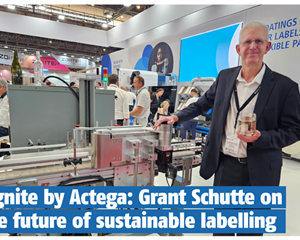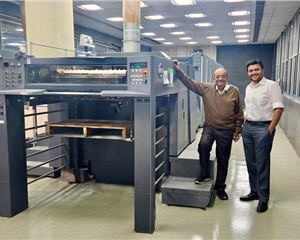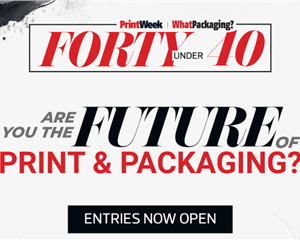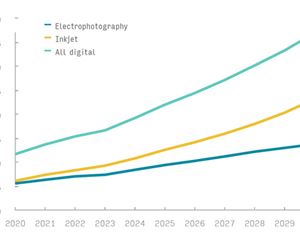The future of metal packaging sustainability, innovation, and digital transformation – The Noel D’Cunha Sunday Column
On 28 July 2025, PrintWeek, in association with DIC India, hosted a webinar with over 200 delegates to explore the transformative potential of metal packaging in a dynamic global market
14 Aug 2025 | By Noel D'Cunha
Industry leaders from Beiersdorf, Sun Chemical, and DIC India shared insights into how sustainability, digital engagement, and advanced printing technologies drive the sector forward. The discussion highlights metal packaging’s role as a durable, recyclable, and consumer-centric solution, addressing modern demands for eco-conscious branding and innovative design.
From Mumbai to Spain and Lithuania, the webinar brought together diverse perspectives, reflecting the global reach of an industry poised for significant growth.
India’s aerosol can production, rising from 10-million in 1972 to 800-million today, underscores the market’s expansion, while metal’s high recycling rates of 74.5% for aluminium and 82.5% for steel position it as a leader in reducing post-harvest losses worth GBP 9.2-billion annually in India.
The webinar’s perspective emphasised the industry’s engineering prowess, noting that metal cans undergo nine precise manufacturing processes to ensure quality, durability, and safety.
Noel D’Cunha delves into the webinar’s key themes, offering a comprehensive look at how metal packaging shapes a sustainable, innovative, and digitally connected future in response to evolving consumer expectations and global challenges.
Debasish Mandal, head of packaging predevelopment and sustainability at Beiersdorf's emerging markets regional R&D centre in India, highlights the shift in consumer behaviour, driven by increased confidence, disposable income, and a demand for digital interaction. “These are not the typical consumers of yesterday. They are more confident, have more money, and are conscious of properties like digital connect,” he states.
Mandal says that brands leverage packaging surfaces to create digital touchpoints, with QR codes transforming cans into gateways for rich content, such as product details, gamified experiences, or interactive campaigns. This digital integration engages consumers on platforms like Instagram and Twitter, fostering connections that extend beyond the physical product.
For instance, scanning a QR code on a can unlocks virtual product demos or loyalty programmes, enhancing engagement and providing brands with valuable data. Personalisation transforms metal packaging into a storytelling medium. Advanced printing technologies enable brands to produce small, customised batches tailored to individual or regional preferences.
“By using the right kind of printing machine and processes, you can do wonders with a small lot. You can convey your message. You can onboard the consumers by personalisation,” Mandal explains, showcasing Beiersdorf’s 8x4 brand, which links fragrances like Vibrant Flower, Juicy Splash, Fresh Lime, and Wild Oak to specific colours.
This sensory connection resonates with Gen Z, who value unique, visually appealing designs. The simplicity of these designs ensures clarity while enhancing brand appeal, making metal packaging a versatile canvas for modern branding.
Sophisticated printing capabilities underpin digital and personalised packaging. Mandal notes that Beiersdorf’s machines, equipped with multiple stations for primers, lacquers, and inks, reproduce complex artworks, including gradients and fine typography, with precision. “We didn’t face any issue, and our artworks could be reproduced within these machinery setups,” he responds to an audience question, underscoring the flexibility of modern systems. This capability allows brands to experiment with bold designs without compromising consistency, ensuring that metal packaging meets both aesthetic and functional demands.
Digital connectivity aligns with consumer trends toward immediacy and interactivity. By embedding augmented reality triggers or QR codes, brands offer immersive experiences, such as virtual tours of product origins or interactive games, directly from the packaging. This approach not only enhances engagement but also provides insights into consumer preferences through data analytics. The host perspective reinforces that packaging evolves beyond protection, becoming a branded, shelf-ready solution that resonates with tech-savvy consumers, particularly in markets like India, where digital adoption accelerates.
The webinar’s emphasis on digital trends reflects the industry’s response to a cultural shift. As consumers demand seamless integration between physical products and digital platforms, metal packaging adapts to deliver interactive, personalised experiences that strengthen brand loyalty and drive market competitiveness.
Sustainability, a commitment to circular economies
Sustainability anchors the metal packaging industry, with its infinite recyclability setting it apart. Mandal details Beiersdorf’s ambitious goals, including a net-zero commitment by 2045 and a 90% reduction in absolute carbon emissions, validated by the Science-Based Targets initiative (SBTI) and CDP compliance. “Aluminium is infinitely recyclable. If you can avoid primary production by proper recycling, we’re going to eliminate almost 90% of the energy consumption in the whole process,” he explains.
Beiersdorf’s Nivea tins, produced exclusively in Germany, incorporate 85% recycled aluminium, maintaining product and packaging integrity. Their aerosol deodorant cans transition to low-carbon and recycled materials globally, supported by a dedicated team sourcing sustainable partners.
The company’s journey to integrate recycled aluminium began four years ago, requiring collaboration with suppliers like Novelis and the Aditya Birla Group. “We are closely associated with the aluminium organisation as a supplier, and also the recycled aluminium companies,” Mandal notes, highlighting challenges in aligning lacquers and primers with recycled aluminium.
Rigorous trials ensure success, achieving 85% recycled content in Nivea tins without compromising quality. The company targets 100% recyclable metal packaging by 2032, aligning with their “Care Beyond Skin” philosophy, which emphasises environmental responsibility alongside diversity in gender, technology, and geography.
Lander Lopez, Asia business leader for the metal packaging inks sector with DIC Corporation- Sun Chemical, underscores industry-wide sustainability efforts. He says, “Some brand owners like Coca-Cola, PepsiCo, or P&G have common goals in terms of sustainability. One of them is to make 100% of the packaging reusable or recyclable between 2025 and 2030.”
DIC aims to increase sustainable products to 60% of net sales by 2030 and reduce carbon dioxide emissions by 50%, targeting net-zero by 2050. These goals reduce reliance on virgin materials, positioning metal packaging as a sustainable alternative to plastics, which face recycling challenges due to material degradation.
Metal’s high recycling rates, 74.5% for aluminium and 82.5% for steel, make it ideal for circular economies. Metal’s durability and barrier properties protect products from light, oxygen, and moisture, reducing waste and extending shelf life, which is critical for addressing India’s GBP 9.2-billion in annual post-harvest losses. Beiersdorf’s global sourcing strategy and DIC’s focus on renewable materials reflect the industry’s shift toward sustainable practices, driven by consumer demand and regulatory pressures.
Metal’s systemic advantages include its ability to retain properties through multiple recycling cycles, unlike plastics. The webinar emphasises that sustainability is not just a trend but a strategic imperative, with metal packaging leading the way in balancing environmental responsibility with practical functionality, setting a benchmark for eco-conscious branding.
Technical innovation in printing precision and performance
Gonzalo Malo de Molina, technical leader of metal deco inks at DIC Corporation-Sun Chemical, provides a comprehensive overview of technical advancements in metal packaging. As global manager of technical customer service, he leads a team of 20 chemists, including four with doctorates, at Sun Chemical’s Metal Packaging Centre of Excellence.
“Innovation is at the heart of what we do,” Malo de Molina says, focusing on research and development, customer support, and colour management. His company’s labs feature advanced tools like spectrophotometers, high-performance liquid chromatography, gas chromatography, and pilot-scale production capabilities, simulating industrial processes to ensure precise formulation and performance evaluation.
Colour management is critical for metal surfaces, where precision and consistency are essential. “We help them maintain the colours across the different printing places all around the world,” Malo de Molina explains, highlighting Sun Chemical’s collaboration with Pantone on the PantoneLive library for three-piece cans.
This project digitalises Pantone colours for aluminium substrates, ensuring accurate reproduction without relying on paper-based standards. Their formula conversion calculator streamlines transitions from competitors’ inks, minimising disruption for global brands, while regular benchmarking and complaint analysis maintain competitiveness.
Lopez provides historical context, noting the slow evolution of printing technology. “In 1888, Myland presented the first printing press. In 1995, KBA’s Metal Star One was a revolutionary change in the industry,” he says, describing the progression to modern systems like the Metal Star Four. UV inks dominate globally, followed by conventional inks, with LED inks emerging as the future due to energy efficiency.
Malo de Molina addressed challenges like UV ink transfer, advising, “You need to ensure that the cure of the UV ink is properly done,” emphasising low water usage, clean lamps, and appropriate ink film weight to prevent set-off during stacking.
Printing challenges, such as ink filling in reverse text, require precise solutions. “You need to ensure that when you are producing the colour, you are not using excessive ink film weight,” Malo de Molina advises, stressing correct printing pressures between rollers, plates, and cans.
Varnishing enhances aesthetics, particularly for premium or matte finishes. “Matte varnish reduces the chroma, creating a very attractive satin, matte finish,” he notes, balancing functionality and visual appeal. These solutions ensure durable, vibrant finishes for branded packaging.
Sun Chemical’s focus on sustainable inks, like UV and LED formulations, reduces energy consumption, aligning with industry trends. The host perspective emphasises that printing transforms cans into branded solutions, requiring mastery of the entire process from forming to finishing. Technical innovation remains a cornerstone, enabling metal packaging to meet the demands of precision, sustainability, and global branding.
DIC India is pioneering sustainable solutions
Karthikeyan Sambandam, DGM, Metal Deco, DIC India, shares insights into their 75-year legacy, starting with Coates Brothers in 1947 and integrating into DIC Corporation in the early 2000s.
“DIC India has a presence in India for more than 75 years,” he notes, highlighting their platinum-rated green facility in Saykha, Gujarat. Certified by the CII India Green Building Council, the plant uses renewable energy, supporting DIC’s net-zero goal by 2050 and helping brands meet Scope 1 and Scope 2 emission targets. With over 10,000-metric tonnes of annual capacity and 50% expansion potential, the facility drives sustainable ink production.
DIC India’s portfolio includes UV and LED inks under the METCURE brand, designed to reduce energy consumption. “We started manufacturing UV inks in our Gujarat plant under the brand name Metcure, and LED inks are in the development stage,” Sambandam says. While conventional inks dominate 60% of the Indian market, 40% has shifted to UV inks, with LED inks poised to lead. “LED is going to be the future of the Indian market,” he predicts, citing reduced costs and compatibility with modern printing lines.
Beyond metal packaging, DIC India offers sustainable solutions like water-based, toluene- and ketone-free inks, and barrier coatings for food safety. “We offer barrier coatings, which can be coated to prevent contamination between the food and the packaging product,” Sambandam explains. Their chic wash solution removes ink before recycling, supporting circular economy goals. Low-PAH inks for newspaper printing address toxicity concerns, reinforcing DIC India’s commitment to safe, sustainable solutions across diverse segments.
Sambandam tackles technical challenges, such as ink filling in reverse text printing.
“We have specifically formulated products suitable for reverse printing technology, which can avoid spillage,” he notes. With R&D centres in Noida and plants in Ahmedabad, Bangalore, and Saykha, DIC India delivers high-quality, compliant inks. The host perspective highlights the strategic importance of these innovations in India’s growing market, where sustainable and efficient solutions are in high demand.
DIC India’s renewable energy-powered facility and expanding portfolio of low-energy inks position them as a key partner for brands balancing performance and environmental responsibility. Their focus aligns with global trends, as brands prioritise eco-friendly packaging to meet consumer and regulatory expectations.
Market trends and global competitiveness a growing industry
The global metal packaging market grows from GBP 119.3-billion in 2022 to a projected GBP 170.5-billion by 2032, with India and the Asia-Pacific region leading due to rising disposable incomes, industrialisation, and demand for convenience foods. Lando Lopez identifies six key consumer trends: “There are six key factors: cultural shift, technological barriers, convenience and urban lifestyles, economic stress, green thinking, and life quality,” he explains. In Asia, buy-online-pick-up-in-store (BOPIS) models and social buying via apps like WeChat and TikTok reflect demands for convenience and digital engagement, which metal packaging meets with durable, portable solutions.
Lando highlights India’s potential in three-piece cans. “There is a huge potential in terms of three-piece metal packaging business,” he says, noting LED inks’ growing popularity due to energy savings and reduced space requirements. However, “LED is still at the last place, because customers have some doubts to make that step,” he adds, indicating a gradual shift from conventional inks, which hold 60% of the market. UV and LED technologies drive efficiency, addressing cost and environmental concerns.
Eduardo addresses trade policy challenges. “There is a higher risk for metal packaging of suffering an impact of the trade war that we are now living in,” he says, noting volatile aluminium and steel costs compared to plastic, Tetra Pak, or glass. Yet, metal’s recyclability enhances competitiveness. “The high recyclable level we have in the metal packaging is quite competitive with other industries,” Lando adds, countering greenwashing perceptions by emphasising sustainability advantages for food and beverage applications.
The host perspective underscores the engineering marvel of metal cans, which undergo nine precise processes to ensure quality, durability, and safety. The shift toward recyclable, compliant, and value-added packaging accelerates, with two-piece and three-piece formats gaining traction. The webinar’s call to “think before you ink” emphasises strategic material and technology choices, positioning metal packaging as a cornerstone of modern branding.
India’s market growth, driven by consumer trends and metal’s ability to reduce £9.2 billion in post-harvest losses through superior barrier properties, enhances its appeal. The combination of sustainability, technological advancements, and regional dynamics ensures metal packaging’s continued evolution in a competitive global landscape.
Watch the complete webinar here.
Also register for our HP-Redington webinar on 'How HP digital printing is reshaping print and publishing' this Tuesday (19 August) at 3PM. Register here.












 See All
See All